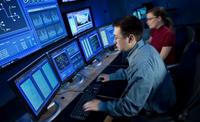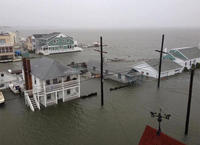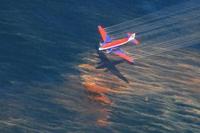-
Critics: post-Fukushima nuclear power may be safer, but it is still not cost effective
The Southern Company wants to show its customers that it has learned from the Fukushima disaster in Japan and has protected its nuclear reactors to make sure the same thing does not happen in the United .States’ critics of nuclear power are not convinced – and also, they say, alternative energy sources, such as natural gas, are much cheaper to produce
-
-
New York is home of the terror bar
Islamic terrorists from around the world are being extradited to the Federal District Court in Manhattan or Brooklyn to face prosecution, which is a boon for the qualified lawyers who defend them; the skills these lawyers display often go beyond what can be taught in law school
-
-
Responding to future oil spills: lessons learned from Deepwater Horizon
A special collection of articles about the Deepwater Horizon oil spill provides the first comprehensive analysis and synthesis of the science used in the unprecedented response effort by the government, academia, and industry;with the benefit of hindsight and additional analyses, these papers evaluate the accuracy of the information that was used in real-time to inform the response team and the public
-
-
DARPA’s program to reveal backdoors, hidden malicious functionality in commercial IT devices

The scenario is one that information security experts dread: widespread dissemination of commercial technology which is secretly wired to function in unintended ways or even spy on its users; from this vantage point, mobile phones, network routers, computer work stations, and any other device hooked up to a network can provide a point of entry for an adversary; for the Department of Defense this issue is of great concern, and DARPA pland to do something about it
-
-
New U.S/Canada Border Conference aims to advance “Beyond the Border” declaration
To further the goals of the February 2011 U.S.-Canada joint declaration, “Beyond the Border: A Shared Vision for Perimeter Security and Economic Competitiveness,” Eagle Eye Expositions, LLC will present a new event called the U.S./Canada Border Conference; the event will take place 10-11 September 2013 at the Cobo Center, Detroit Michigan
-
-
Mixing oil with dispersant increased toxicity to Gulf’s ecosystems
If the 4.9 million barrels of oil that spilled into the Gulf of Mexico during the 2010 Deep Water Horizon spill was an ecological disaster, the two million gallons of dispersant used to clean it up apparently made it even worse – fifty-two-times more toxic
-
-
Fracking in Michigan
In hydraulic fracturing, large amounts of water, sand and chemicals are injected deep underground to break apart rock and free trapped natural gas; though the process has been used for decades, recent technical advances have helped unlock vast stores of previously inaccessible natural gas, resulting in a fracking boom; researchers are examining the benefits of fracking for Michigan
-
-
Post-Sandy insurance rates increase may make coastal living unaffordable

Residents of New York and New Jersey are still coping with the destruction Hurricane Sandy caused, but home and business owners alike will soon face another burden: rising insurance rates and new building codes and requirements that could threaten many that live and work in the coastal areas of the two states
-
-
Technology transfer from U.S. federal laboratories to private entities, other governments
In 2010 the eleven U.S. federal laboratories had more than 18,000 active collaborative relationships with private entities and other government agencies, disclosed more than 4,700 inventions, submitted 1,830 patent applications, and received 1,143 patents
-
-
American West's changing climate means economic changes, too
The State of the West Symposium, hosted by the Bill Lane Center for the American West and the Stanford Institute for Economic Policy Research, featured a discussion of the Western United States’ future of extreme heat, declining snowpack, and what it all means for the region’s industry, electricity generation, and policy
-
-
DHS awards $23.6 million to fund development of new software analysis technology
DHS awarded a $23.6 million grant to the Morgridge Institute for Research at the University of Wisconsin-Madison to create the Software Assurance Marketplace, which, over the next five years, will work closely with developers of new software analysis technology and the open source community to advance the security of software; initial operating capabilities for the Software Assurance Marketplace will include the ability continuously to test up to 100 open-source software packages against five software assurance tools on eight platforms, including Macintosh, Linux, and Windows
-
-
Water resources management in a changing world
Visualize a dusty place where stream beds are sand and lakes are flats of dried mud; are we on Mars? In fact, we are on arid parts of Earth, a planet where water covers some 70 percent of the surface; how long will water be readily available to nourish life here? In the United States, more than thirty-six states face water shortages; other parts of the world are faring no better
-
-
World’s great rivers running on empty
Four of the world’s great rivers are all suffering from drastically reduced flows as a direct result of water extraction, according to new research; the researchers found that in all four river basins, over a long period of time, outflows have greatly reduced as a direct result of increased water extractions, and that urgent changes in governance of water are needed to ensure the systems remain healthy and viable
-
-
Learning the lessons of the BP oil spill

In an attempt to limit the harm of the Deepwater Horizon oil spill in the Gulf of Mexico in 2010, three million liters of dispersant were used to dissipate the oil; on the surface the damage seems limited, but the seabed is covered with a thick layer of gunk; scientist from around the world are now working on models that can be consulted by decision makers when there is another oil spill disaster
-
-
The challenge of securing food and water supplies in the twenty-first century
Participants in the Food Security in Dry Lands (FSDL) conference, held last week in Qatar, agreed that the task of managing food and water resources more efficiently and improving the security of supply are set to become one of the biggest challenges for policy makers in the twenty-first century
-
More headlines
The long view
Factories First: Winning the Drone War Before It Starts
Wars are won by factories before they are won on the battlefield,Martin C. Feldmann writes, noting that the United States lacks the manufacturing depth for the coming drone age. Rectifying this situation “will take far more than procurement tweaks,” Feldmann writes. “It demands a national-level, wartime-scale industrial mobilization.”
Trump Is Fast-Tracking New Coal Mines — Even When They Don’t Make Economic Sense
In Appalachian Tennessee, mines shut down and couldn’t pay their debts. Now a new one is opening under the guise of an “energy emergency.”
Smaller Nuclear Reactors Spark Renewed Interest in a Once-Shunned Energy Source
In the past two years, half the states have taken action to promote nuclear power, from creating nuclear task forces to integrating nuclear into long-term energy plans.
